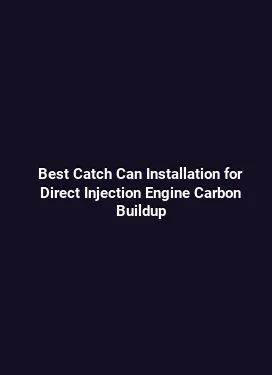Velocity Stack Design Guide for Individual Throttle Body Setups
Individual throttle body (ITB) configurations offer a distinctive approach to air handling, allowing precise control over throttle response and intake dynamics. The velocity stack, a carefully shaped inlet trumpet that attaches to each throttle body, plays a pivotal role in establishing the desired air pressure wave, minimizing flow losses, and promoting efficient fuel atomization. This guide delves into the core principles of velocity stack design within ITB systems, outlining practical considerations for intake plenum geometry, fuel delivery compatibility, sensor placement, and maintenance practices. The goal is to translate aerodynamics and fuel management theory into actionable steps that improve throttle response, mid-range torque, and high-end power without compromising driveability.
Understanding Velocity Stacks and ITB System Synergy

Velocity stacks are more than decorative air inlets; they shape the pressure field immediately upstream of each throttle plate. In ITB setups, each cylinder has its own intake runner, reducing the cross-talk common in single-throttle manifolds and allowing more predictable cylinder-to-cylinder air distribution. The design objective is to maximize the effective air mass flow entering each runner while preserving a stable pressure wave that complements the engine’s breathing at different RPM ranges. A well-tuned velocity stack minimizes boundary layer separation, smooths the transition from stack to runner, and avoids sharp discontinuities that can trigger flow separation at high engine speeds.
When paired with a properly engineered plenum and runner lengths, velocity stacks support a favorable impedance match across the operating map. The impedance match refers to how resistance to flow changes with RPM and air density; a stack designed for a specific engine displacement, cam profile, and RPM band will deliver cleaner signal-to-flow characteristics to fuel injectors and ignition timing strategies. In short, velocity stacks set the stage for effective volumetric efficiency by shaping the incoming air without forcing a dramatic pressure drop inside the throttle body itself.
Aerodynamics, Plenum Geometry, and Flow Profiling
The geometry of the plenum and the arrangement of velocity stacks profoundly influence air distribution. An optimized plenum reduces short-path air travel disparities and minimizes wave reflection that can create uneven pressure across cylinders. Important geometric considerations include the total plenum volume, the diameter and length of each velocity stack, and the alignment of stack entrances relative to the intake runner mouths. A common target is to ensure that the velocity stacks present a consistent, laminar-ish flow profile at the throttle plate interface, even as intake air temperatures rise or air density shifts with altitude and ambient conditions.
Designing velocity stacks also means accounting for the natural acoustic resonances of the intake system. While the primary aim is practical airflow, the secondary benefit is a more even pressure distribution along the runners. In practice, this translates to smoother acceleration, reduced fuel slugging at part-throttle, and improved transient response. The walls of the velocity stacks should minimize boundary layer growth and be finished to reduce surface roughness, which can trap small eddies and degrade flow certainty at high RPM.
Stack Entry Radius and Coupling to ITB Throttles

The transition from the stack to the throttle body must be smooth to avoid flow separation. A carefully calculated entry radius reduces turbulence and helps preserve the intended velocity profile as air enters the venturi-like area of the throttle body bore. The coupling interface should ensure a uniform seal while permitting slight misalignment tolerance during assembly. In some ITB systems, a small chamfer or rolled edge on the stack mouth can further reduce transitional losses, especially at high engine speeds where flow is dynamic and rapidly varying.
Material choice for velocity stacks matters for heat conduction and weight considerations. Aluminum stacks tend to provide a good balance of heat resistance and ease of manufacturing, while carbon fiber or composite stacks offer weight savings and reduced thermal inertia. The choice should align with overall vehicle weight targets, heat management strategies, and manufacturing availability, keeping in mind that thermal stability helps maintain consistent air density entering the stacks.
Fuel Delivery, Atomization, and ITB Tuning Synergy
ITB systems create a unique interaction between air delivery and fuel delivery. Precise fuel metering remains essential because each cylinder pair operates with a distinct air mass flow pathway. The velocity stack influences the air velocity and density at the intake valve, but the fuel injectors and their spray characteristics must synchronize with these dynamics to achieve optimal combustion. Proper injector sizing, fuel pressure, and rail design contribute to reliable atomization, particularly at part-throttle and cold-start conditions where the risk of fuel pooling and misfire increases.
In practical terms, ITB tuning benefits from a holistic view of the air-fuel diagram. A faster air change within the stack can demand a slight enrichment at certain RPM bands to avoid lean spikes caused by transient high-velocity intake. Conversely, at lambda-rich or over-lean edges, timing adjustments may be needed to maintain complete combustion without knocking or misfire. The goal is a stable air-fuel ratio across the operating envelope, with the velocity stack providing the most efficient air arrival to the combustion chamber under varying load and RPM.
- Injector placement: In ITB setups, injectors are commonly placed near the throttle body or within the intake runner close to the valve to optimize spray targeting and vaporization. Stack design should accommodate injector geometry without creating interference with air passage.
- Fuel pressure and return dynamics: A steady fuel supply with minimal pulsation is crucial. Consider dampening components or integrated fuel rail designs that reduce pressure fluctuations caused by rapid throttle movement.
- Atomization efficiency: High-velocity air can help improve atomization by promoting better fuel vaporization, but extreme venturi effects can also pull fuel too aggressively in certain regimes. Balance is key.
The synergy between air and fuel systems is particularly evident in cold-start and hot-start behavior. Velocity stacks that promote smoother air flow reduce the likelihood of lean misfire during warm-up. In contrast, a well-calibrated fuel map can ensure that transient air accelerations do not lead to abrupt richness changes that would upset idle stability.
Sensor Placement, Calibration, and Data-Driven Tuning
ITB configurations rely on accurate sensor feedback to manage fueling and timing. Key sensors include manifold absolute pressure (MAP) or atmospheric pressure, intake air temperature, and, depending on the engine management strategy, air mass meters or direct fuel sensing. The physical placement of these sensors relative to velocity stacks and runners matters because it affects the reference pressure that the ECU uses for fueling calculations. Improper sensor location can introduce lag, signal noise, or delayed correction during rapid throttle movements.
Calibration steps should emphasize matching sensor readings with real-world air density and velocity profiles inside the intake tract. A practical approach includes three phases: baseline measurement with a steady idle, transient testing during wide-open throttle (WOT) in a controlled RPM band, and hot-start/restart validation. During each phase, compare observed AFR (air-fuel ratio) behavior, ignition timing, and intake vacuum signals to expected targets. Adjustments to injector timing, duration, and alignment to the velocity stack geometry can yield a more consistent fueling response across the operating range.
Dynamic Tuning Practices for ITB Venues
Dynamic tuning leverages data logging to refine velocity stack performance. Common practice involves monitoring intake vacuum waveforms, pressure drop across each throttle plate, and per-cylinder AFR consistency. Insights gleaned from these measurements guide adjustments to stack length, plenum volume, and the intercoupling between adjacent stacks. For example, slightly lengthening a stack can shift resonance in a way that broadens the usable RPM range for smooth torque delivery, while reducing stack length may improve high-RPM responsiveness at the expense of low-end torque consistency.
Engine management strategies should also incorporate trend indicators such as throttle response time, misfire events, and fuel trim stability. The ultimate objective is to establish a robust map where velocity stacks participate in shaping favorable intake waves without introducing excessive latency in fuel correction. Well-tuned ITB velocity stacks contribute to a more linear torque curve, enhanced throttle response, and a more engaging driving experience across varied driving conditions.
Practical Installation, Maintenance, and Troubleshooting
Implementing velocity stacks in ITB systems requires careful assembly and cadence with other intake components. Practical steps include ensuring clean, matching gasket surfaces, using anti-seize compounds where appropriate, and verifying full seal integrity across all interface joints. Uneven gaps or misaligned stacks can create leak paths that undermine intended airflow and fuel control. A robust mounting scheme reduces vibration-induced wear and keeps stacks aligned with the throttle bodies under dynamic driving conditions.
Maintenance involves periodic inspection of stack surfaces for corrosion or heat-related deformation, verification of hardware torque specifications, and cleaning air paths to prevent deposit buildup that can alter cross-sectional area and velocity. When replacing or upgrading stacks, maintain consistent interior surface finish and consider re-tuning the engine management map to reflect any changes in flow characteristics. A systematic approach to calibration, including a fresh baseline on a dynamometer or controlled road testing, helps ensure that the modifications deliver the anticipated gains without introducing driveability issues.
Practical tips for performance-minded road enthusiasts include selecting stacks with a radius or flare that minimizes inlet eddies, aligning stack orientation to reduce water drainage risk in humid environments, and using heat-insulating materials to limit evaporative losses and inlet air heating that can degrade density. In high-performance applications, some builders opt for CNC-machined velocity stacks with custom cross-sectional profiles to achieve a targeted impedance curve, but even off-the-shelf designs can yield meaningful improvements when paired with thoughtful plenum and runner tuning.
Integration with Overall Intake & Fuel Systems
Velocity stack design does not exist in isolation. The most successful ITB configurations demonstrate harmony between air handling, fuel management, and engine calibration strategies. The synergy is achieved by aligning stack geometry with runner lengths, plenum volume, injector placement, and the chosen engine management approach. An integrated workflow begins with defining desired torque and power targets, followed by iterative testing to refine stack dimensions, air-fuel maps, and ignition parameters. When done correctly, the result is enhanced throttle response, linear torque delivery, and robust high-RPM performance that remains tractable in everyday driving scenarios.
For enthusiasts considering a velocity stack upgrade, a staged approach is recommended. Start with a proven stack-to-runner interface, then evaluate the impact on idle stability and response. Next, adjust plenum volume to optimize the impedance match and repeat testing across the RPM range. Finally, revisit fuel delivery and ignition mappings to ensure consistent AFR control and timing alignment with the new airflow characteristics. This process minimizes the risk of drivability issues and accelerates the path to meaningful performance improvements.






